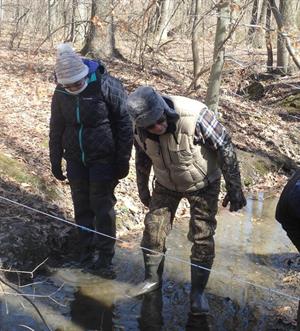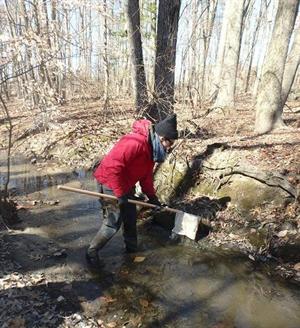Samantha Briggs, IWLA Save Our Streams Coordinator

My very first volunteer stream monitoring experience was in the peak of winter with a group of extremely dedicated volunteers. I had not yet taken any macroinvertebrate identification or stream monitoring trainings, but this group was kind enough to let me tag along and “get my feet wet” to see if monitoring was really for me. I drove to the site and thought I was prepared. I had on jeans, my rain boots, one pair of socks, an average winter coat, a sweatshirt, and gloves.
How bad could it be? (Famous last question!)
After parking my car, I crunched through the snow to find the five volunteers I would be shadowing that day. They were already set up with multiple tables, field microscopes, nets, winter gear, and all the tools we needed to pull samples. Some even had their own magnifiers or jewelers loops on chains around their necks. All of them were wearing more robust jackets than I had on, and they all had stacks of winter gloves on standby.

I quickly began to realize my errors in preparation. My feet quickly chilled to the bone after hopping in the stream. We had to crack some thin ice on the banks to collect our bug samples, and my slick rain boots were a poor choice for the task. As the seasoned volunteers pulled a sample and got their gloves wet, they put on a new dry pair. Once I got my hands wet, I was out of luck. After the bugs were pulled from the stream, we spent hours picking through the sample, identifying them to family level under the microscope. Because of the frigid temperatures, the critters were much more sedentary and difficult to locate in the debris. By the time four hours had gone by, we were almost done identifying all of the bugs and marking them on our data sheet. The volunteers were still chirping about their exciting finds, while I was an icicle, barely able to move or speak.
It is a miracle that I ever wanted to monitor a stream again. I did learn valuable lessons about not only stream monitoring but fully preparing volunteers to go into the field, especially in adverse conditions.
I later found out that winter monitoring for macroinvertebrates is not a great use of volunteer time. Since the bugs are mostly in the small stages of their life cycles or overwinter as eggs, biological stream health will not vary greatly during the winter months. Through the League’s Save Our Streams monitoring program, we suggest biological monitoring during the most temperate times of the year: once in late March through early June and again between September and early November. Biological monitoring takes about 3-5 hours, but it’s only necessary twice a year.
There are plenty of other things you can do in the winter to monitor and improve stream health. Heather Black, our Chesapeake Conservation Corps volunteer, is going to share a few activity ideas with you next week.
Now is also the time to start planning ahead for Save Our Streams trainings in the spring. We are finalizing our preliminary training schedule, which will be posted on our website at iwla.org/workshops. You can also request a training for your own group or chapter! You just need at least 12 people ready to get their feet wet. We can even help you advertise in the community to recruit more volunteers to attend your training. Email sos@iwla.org for more details. (We promise there is no winter biological monitoring required!)